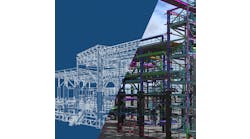To summarize the first article (see On the flyover, February 2010), citing a study done in 1977 as motivation, development work began in 1995 on a thermal infrared (IR) system to surpass the existing bridge nondestructive evaluation technology of that day. That 1995 technology effort has now been newly configured as a commercial bridge inspection tool by building on both recent developments in IR technology and the expansion of proprietary supporting software tools.
The result, BridgeGuard, is able to capture bridge deck conditions, readily analyze and store the data and allow for future reference within its data management system. The simplicity, cost effectiveness and accuracy, along with the ability to analyze, manage and store this critical data will be described in this second article.
On guard
Leveraging the work completed in 1995, an IR optical system, coupled with dedicated and proprietary computer software, was developed to provide the sensor technology necessary to accurately collect and analyze IR data for bridge decks. The system is a vehicle-mounted sensor suite that applies computer software tools designed to get the maximum benefit from the collected data and maintains that data in a way that ensures it is always available for further analysis or information distribution. The test procedure provides a fast and repeatable way to inspect and map delaminations within concrete bridge decks, supports and ramps.
As discussed and illustrated in the first article, bridge deck delaminations can be detected during both daytime and nighttime hours as a result of the natural thermal transition within the structure due to normal diurnal environmental exposure. Delaminations within the concrete interrupt the flow of thermal energy to the inner deck core and, consequently, those areas will show higher or lower surface temperatures than the surrounding solid deck area. The BridgeGuard program exploits this situation by applying an IR camera as a thermal-fault detection device.
The selected state-of-the-art sensor is mounted on a lightweight monopod, developed as a deliverable component to the system, and is positioned above the road to maximize the view of a complete bridge lane. As will be described below, a Global Positioning System (GPS) device is integrated to monitor, in real time and ongoing, the speed at which the vehicle is traveling. The integrated system is easily operated from a van, pickup truck or service vehicle with only the camera monopod rack interface needed, no additional wiring to the vehicle is required.
Location, location
The 1995 system was developed with a position sensor mounted at the rear of the vehicle and was interfaced to a computer, along with the IR imager, for data collection, post analysis and mapping of defect areas. The position sensor had its deficiencies: It was inconvenient, expensive, unreliable and difficult to interface. As a technology enhancement feature, the new system employs GPS, which was not readily available in 1995.
Using a GPS device for precision location mapping is not a realistic application for the bridge deck system. However, the speed provided by the GPS unit is internally calculated based on the rate of change from one position to the next, meaning that a speed measure is a relative value and its accuracy is dependent upon the accuracy of one location to the next and not on the accuracy of the instantaneous position of any one point. Consequently, this makes speed a very useful measure in this application.
The high-speed IR camera allows for much faster speeds than conventional cameras and can therefore complicate the data processing overhead by collecting image frames that provide large redundancies in lane coverage. Using the speed provided by the GPS, calculations are made to indicate how often an image must be collected to ensure that the massive amount of data, and its redundancy described above, is mitigated without the loss of area coverage of the bridge deck. These calculations are made on the fly and in real time to adjust the data collection rate and ensure that the stored data stream represents a mosaic of the entire bridge surface, without loss of surface coverage.
Two-man band
The system is easily operated by a single operator and a vehicle driver. The driver positions the vehicle in a defined lane-flow pattern and, at the onset of each lane inspection, the system operator begins the data-collection process using either the mouse or a function key. Because the inspection vehicle is moving at traffic speeds, traffic-control requirements are virtually eliminated, or at least greatly reduced relative to traditional inspection techniques.
The system maintains all logistic control functions, keeping track of the bridge being inspected and the lane that is currently being evaluated. All image data, calibration parameters and descriptive information relating to the bridge are saved in a bridge-specific database for future analysis. After the inspection is complete, the bridge deck image data is further analyzed to identify and mark problem areas. The system allows the operator to recall images to the screen and outline a shape within the image that is considered a delamination.
Module squad
The full potential of a quantitative IR bridge inspection program cannot be achieved without the in-depth analytical capabilities afforded by an image processing/data management system. A complete IR bridge inspection device, therefore, is one that provides both analytical as well as information-management capabilities integrated with the camera. Combining the information gathered from the imagery with any additional supporting data collected during the inspection process will further enhance the ability to make decisions regarding the integrity of a bridge and allow one to record those decisions for future retrieval and action.
The software package was internally developed and implemented within a modular format with a graphical user interface (GUI), from which the various modules can be invoked.
The Bridge Management module is the first to be selected from the main GUI. An individual bridge is characterized within this module, per the National Bridge Inventory questionnaire, and is meant to be invoked at the bridge office where all administrative functions occur. All bridges to be surveyed during a data-collection session can be placed in the queue and a work order generated for that field action.
The Data Collection module collects all of the image data for each bridge. The GPS unit, camera and all collection-management features are built into this module keeping data collection relatively automated. The only user interaction required is the selection of a bridge lane, when the collection commences and when it ends.
Once the data-collection action is complete, the Data Analysis module is used to post-analyze the findings. The analyst simply steps through the imagery for a bridge and interactively outlines the areas on an image that are considered a delamination. All data for that specific image, lane and bridge is placed in a file, which will be further available for the automated report-generation process.
A report can be generated to present the findings of the bridge-evaluation process. The report includes basic information about the analyzed bridge, images holding delaminations and their details and a bridge map where the delaminations are depicted in their relative position with summary statistical data displayed. The system allows the ability to export a digital copy or print a hard copy of the report as it displays on the screen. The entire mapping process and database generation is highly automated, saving valuable time relative to present manual documentation methods. The created database can be re-entered at any time in the future to revisit the data collected, reprint the Bridge Map and compare subsequent inspections, helping to develop a measure of how the bridge is deteriorating over time and quantifying the rate of change of the delaminations.
An enormous benefit and time saver to this technology redevelopment effort was the ability to configure the operational demonstration data collected in 1995 and leverage that as a readily available data set from which design validation was accomplished, albeit at greatly reduced image quality. Images made using the system present several delaminations in a small area; the delamination is evident by the large contrast changes in the image. Not only can one detect the location of an individual delamination, but one also can characterize its size and shape. This specific capability is the basis for developing analytical tools to map and quantify defects within bridge-deck constructs.
This data also aided in answering frequently asked questions such as whether the system can only see delaminations in concrete and what happens when a layer of blacktop is installed over the concrete decking?
Not completely auto
The software package is continually evolving, with long-term priority goals established to include automated delamination detection analysis, a complete historical database management capability and an expanded high-speed inspection program designed for roadways and highway systems. As the development of the system progresses into phase two, and appropriate data has been collected to verify and validate the updates, they will be implemented to enhance system capabilities.
However, there are several considerations that must be weighed when determining how automation should be implemented. While fully autonomous software-based decision aids are exciting at any level, they are not always a recommended approach. This approach is an all-or-nothing solution that may never actually provide the results that are needed on a given program. Relying solely on the software to detect and characterize each delamination leaves a great deal of additional information that may not be seen by the observer, and therefore, an opportunity to gather a second tier of information regarding the health of a bridge may never be realized. It is believed that the “man in the loop” remains a vital component in supervising the recommendations that the software-based system provides. This automation implementation would be used as a data prescreening tool where the system would be capable of autonomously stepping through the data set and isolating selected frames based on established prescreening criteria. When complete, the user will be left with the analysis of those prescreened images and will apply additional pattern classification algorithms to determine if delaminations do indeed exist on the images.
Similar to the tests outlined in the first article of this series, research is ongoing to validate future development which will include the analysis of roadways, highway systems and other applications. Production of a roadway test slab is under way, similar to the bridge test slab described in the first article, and diurnal tests are being planned to identify, quantify and document the thermal differences between a road and a bridge deck.
Expanding tech
It is without question that to address the growing bridge infrastructure problem, current technologies must be expanded and applied to appropriately utilize available resources. BridgeGuard is an applied expansion of technologies specifically configured and employed to address the bridge deck issues, not only from an inspection perspective, but from a management perspective as well. The potential for inspection time savings is enormous, and the knowledge generated through the use of this program provides valuable information for the ongoing and future management of our country’s bridge systems.


